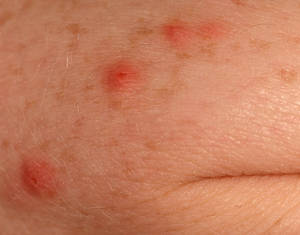The Rise of the Bed Bug
Interview with
Chris - Bed bug infestations are on the rise. Although UK has been relatively clear of them for the last 50 years, we are now seeing a rapid rise in the number of cases, but it's not entirely clear why. Now, scientists are turning to genetic techniques to help them uncover the cause of this bed bug comeback and Toby Fountain is a PhD researcher at Sheffield University where he's looking at this very question. Hello, Toby.
Toby - Hello.
Chris - Ever been bitten by one?
Toby - Unfortunately, I have, yes.
Chris - What was it like? What happened?
 Toby - It's not very pleasant. The thing with bed bugs is they don't like to just bite you once. They tend to bite you several times because they're trying to find a juicy capillary, so what you normally find is you get a row of bites. So, even one individual might bite you 5 or 6 times, so quite grim really.
Toby - It's not very pleasant. The thing with bed bugs is they don't like to just bite you once. They tend to bite you several times because they're trying to find a juicy capillary, so what you normally find is you get a row of bites. So, even one individual might bite you 5 or 6 times, so quite grim really.
Chris - Tell us about the organism responsible. What are these bugs? What do they look like? How would I recognise one?
Toby - Bed bugs are small, flightless parasites that suck on our blood. They're visible to the naked eye and adults are about the size of an apple pip. They're a dark, reddy-brown colour. So, they're quite cryptic. They do hide away in lots of places, but if you saw one on your arm, you'd definitely be able to see it. They're bigger than a flea for example.
Chris - Where do they hang out? We call it bed bugs, but it's that a reasonable name for them?
Toby - They don't actually like being in the bed because they might get squashed, so where they actually tend to live is cracks and crevices around the bed, and what they'll do is when you're sleeping, they'll stealthily march out, they'll bite you, they'll feed on you, and then as quickly as they can, they'll scuttle away to their safe hidey hole. So they don't actually sleep in the bed with you in a majority of cases.
Chris - Reassuring, although not much. How do they find you?
Toby - There's actually a number of mechanisms they use depending on the scale. So, what they can do is they use CO2 for example. So, the carbon dioxide that you breathe out, they can pick up very quickly and when they get a bit closer to you, they use a combination of infrared and also they smell you. The chemicals coming off your body, they smell you and that's kind of how they locate you.
Chris - And then the rest is history, I suppose you could say. Speaking of which, looking back in time, these organisms, these insects were much more common as a pest in people's homes than they are today thankfully. Why were they more common then and why did they disappear?
Toby - Yes, that's the thing a lot of people don't know is they were very common in the UK until about the 1940s and it was a part of everyday life for people to live with bugs. But when it got sort of about the 1940s, the government here introduced more stringent public health legislation and we also saw the development of powerful insecticides like DDT, and they've been presumed to be what's been responsible for bringing the numbers right down. Now, the mystery is that in the last 10 or 15 years, they've started coming back. We're starting to get increased reports of them and what we're trying to do is kind of work out why that is.
Chris - Is that a comprehensive thing if you look at pretty much any western country, you're going to find this similar sort of trend or is it just in Britain?
 Toby - No, no. It's seen across the western world, the United States and Australia for example. They haven't really had very many reports of bugs until a similar time, so that's the interesting bit; that this pattern has happened globally at the same time.
Toby - No, no. It's seen across the western world, the United States and Australia for example. They haven't really had very many reports of bugs until a similar time, so that's the interesting bit; that this pattern has happened globally at the same time.
Chris - And in countries that didn't use insecticides and things, have they always stayed high or was there just a massive global reduction in their incidents?
Toby - No, I think they're still maintained. For example, in Africa, they have always had a high number of bugs and that's still been a common feature of life out there.
Chris - So, how are you using the power of genetics in your research to try to understand a bit about what these insects are doing?
Toby - First and foremost, I'm an Evolutionary Biologist, so one of the things I'm interested in is how genetic diversity is maintained within populations. So we know genetic diversity is very important as it will allow organisms to adapt to external pressure. Now bed bugs are very interesting because it looks like humans are responsible for moving them around. What my research is finding is that it's usually just a very small number of related individuals that eventually start new infestations. And because this number is so small, you get quite a lot of inbreeding and mating with relatives causes a reduction in your genetic diversity which can be detrimental for many species, but not the bug.
So, what we're using is basically DNA fingerprinting. This allows us to look at different variable regions in bed bug DNA between individuals and then we can compare how related individuals are. Now, this is very interesting from an evolutionary standpoint, but it also has a number of very useful practical applications. For example, we're starting to identify the exact numbers of bugs which do start infestation. And also, what we'll be able to do is identify what infestations are linked which is going to have some important practical applications for pest controllers.
Chris - So, do you have to go sites of outbreaks and physically find bed bugs or do people kindly send them to you?
Toby - It's actually a combination of the two. I remember early in my PhD, it was a bit strange because I was advertising for people to send me their bugs which I hadn't expected when I started. I've also been to a number of infestations myself and it's really that side of my work that's really opened up to me how much of a problem they are. When I started, I read the literature. They sounded like they're pretty bad, but I think it's not until you've actually stepped inside a home with a substantial bug problem, and you see how horrible it actually is, and what real pressure there is to try and to come up with adequate control strategies to get rid of them.
Chris - And returning to your question of studying diversity of bed bugs. You do the genetic fingerprinting. You are able to study how these things originate and how they spread. What actually are you able to tell about the pattern of spread? Are we able to blame low cost airlines for sending people off on package holidays, they then stay in low cost accommodation which is riddled with bed bugs, bring them back here, and then they spawn an outbreak at home, and then that propagates around the country?
Toby - Okay, well the first thing we can say is actually that cleanliness of a property has very little to do with the chance of having a bug. You're as likely to get them from a very cheap hotel or hostel as you are to from one unlucky high class hotel, which could have them equally as much. While it's probably a bit early to say if they're coming from a certain place or not, what we're definitely finding is a pattern of humans moving them around. So, if you remember I said at the start that bed bugs can't fly. They can only walk. So, what you might expect in that situation is, the further you go away from an infestation, the less related individuals are going to be...
Chris - Well, they can fly if you put them in an airplane of course.
Toby - Exactly, so what you can do with that is you can see that naturally, if we weren't contributing to that spread, if humans weren't contributing, we'd see this isolation by distance pattern, we'd see that it's the further you move away, the less related a bug would get. But you rightly said, couple that with us now flying a lot more, we're not seeing that expected pattern. So, that is giving support that humans are actually facilitating their long range spread.










Comments
Add a comment